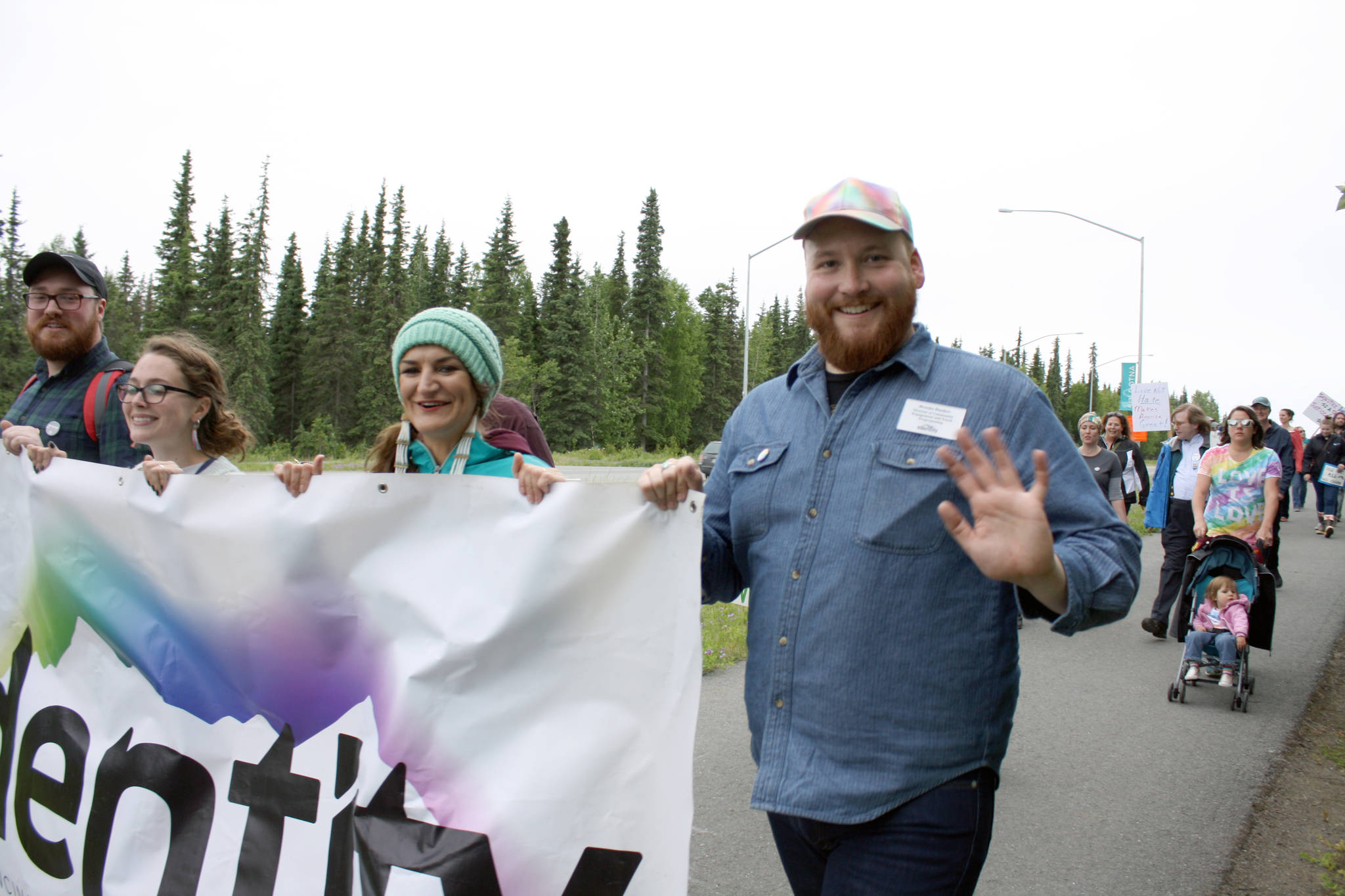Carrying signs, flashing smiles and eliciting the occasional friendly smile or honk from passing cars, approximately 60 rainbow-clad marchers made history Wednesday.
The group, which walked from Sports Complex to Soldotna Creek Park, was taking part in the Two Spirit Pride
March — a celebration of lesbian, gay, bisexual, transgender and queer communities.
Commemorating the June 28, 1969 New York City Stonewall Riots that marked the beginning of the modern LGBTQ rights movement, Pride marches, parades and events take place around the world annually in June.
“I think it was amazing,” Audre Gifford, Kenaitze Tribe’s Yinihugheltani suicide prevention program, said. “It’s way more than expected and I think there was tons of positive support. Everyone seems so happy and loving. It’s great.”
Gifford spearheaded Two Spirit march as a way to show support for LGBTQ youth, who are particularly vulnerable to self-harm and suicide.
“We’re noticed that suicide rates for indigenous youth who identify as LGBTQ was extremely high, so I really wanted our community to feel that support and our youth to feel support and not feel alone,” Gifford said.
Nationally, the percentage of gay, lesbian and bisexual youth between ninth and 12th grade seriously contemplated suicide at three times the rate of their heterosexual counterparts, according to a 2015 survey by the Centers for Disease Control and Prevention, and 40 percent of trans adults reported having made a suicide attempt, according to the 2015 U.S. Transgender Survey produced by the National Center for Transgender Equality.
Suicide was the sixth-leading cause of the death in Alaska in 2016 with Alaska Native/American Indian populations were 2.1 times as likely to die by suicide, according to the 2016 Alaska Vital Statistics Annual Report released in September 2017 by the Department of Public Health and Social Services.
Leslie Byrd, who works for the Kenai Peninsula College ResLife program and handed out stickers during the Wednesday market ahead of the march, said overall the reception to the day’s Pride celebration was positive.
“We had a couple people kind of say things and walk off, but it wasn’t anything horrible or hateful,” she said. “It was just disagreements, which, that’s America. We’re allowed to disagree, but they were very civil.”
Byrd organized online outreach for the event after Gifford attended one of the LGBT Alliance meetings, a social club and support group for LGBTQ students and allies at the college.
“Audre came to our group and said ‘hey, we’re thinking of doing it as part of Kenaitze what do you guys think?’ And we’re like, ‘yeah, sounds cool,’” she said.
Soldotna resident Blain Cobban, who recently graduated from the Alaska Institute of Technology in Seward, was attending his first Pride event.
“I feel good,” he said. “There’s lots of love out here, and it’s nice to see the whole community come out to this.”
He said he wants to continue to be engaged in LGBTQ events, and hopes visibility will help further acceptance from people in the community.
“I think this is not something they’ve seen,” he said. “I think his whole parade — seeing it in public — I think it should be good for them.”
Although the march was locally organized, a representative from Identity, an Anchorage-based nonprofit that provides support and resources for the LGBTQ community, traveled to the peninsula to participate.
“I’m just so happy that Audre was able to do this, and for me to be able to be a part of it, ” Brooks Banker, director of community engagement and youth programming, said. “I’m just honored to be here representing Identity.”
A newcomer to Alaska, Banker said he’s been impressed to see communities rallying to support the LGBTQ community in what is a traditionally conservative state.
“It is extremely inspiring to see the small communities building Prides,” he said.
This year, Alaska saw a number of Pride events, including Juneau, Talkeetna, Anchorage, Ketchikan and Homer — where approximately 300 people turned out last week.
“It’s really important as community members — whether you’re a teacher or a counselor in a camp, or a counselor in a school, or some kind of adult, or peer supporter — that you do give that love and that support,” he said. “ And maybe point them in the direction of identity or other education or supportive groups, so they don’t feel alone. Because unfortunately what is often a tragic end is self-harm and suicide, and that is because they do feel alone, and they don’t feel they have support. So be that person for them.”
Soldotna High School junior Finn — who asked to only be identified by his first name — held a sign during the parade saying, “I’m the scary trans person the media warned you about.”
“This is the first pride event I’ve been to in my life, and I’m ecstatic,” he said.
He emphasized the importance of having adults to go to.
“They can bring you a lot more experience and input onto the issues that you’re facing, when a lot of other people can’t,” he said.
There aren’t any support groups at his high school for students like him and others in the LGBTQ community, he said, and he faces discrimination regularly.
“Throughout my high school experience … I’ve seen a lot of hatred from other people,” he said.
Going to the Pride March, however, made him feel more welcome.
“I haven’t been to anything like this, and I didn’t know how many people were going to come,” he said. “And it’s just overwhelming how many people were here and how many people honked at us and were waving and saying hi.”

